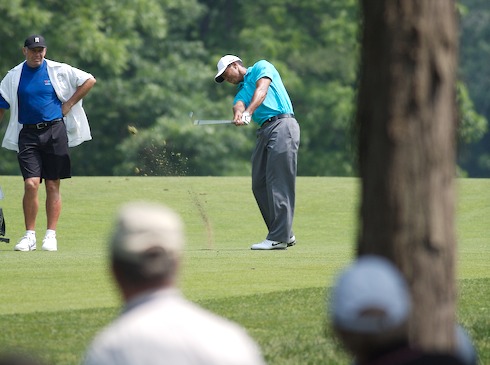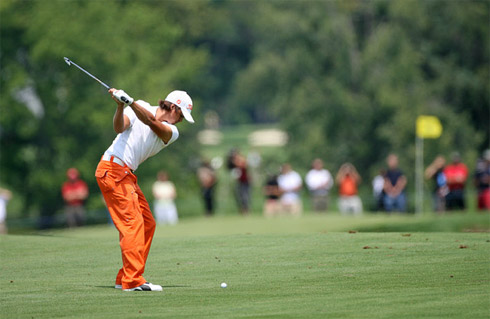 Even though the season has been over for a while now, there is still a lot going on in golf. Q-School just wrapped up, and the PGA Tour has a bunch of new members. Tiger’s Chevron World Challenge provided one of the most exciting finishes of the year, and the pick of Rickie Fowler as PGA Tour Rookie of the Year has provided some controversy (in the form of “Why not Rory?”). Speaking of controversy, it has been almost a year since the groove rule kicked in for pros, and we’ll take a look back on just how well it worked.
Even though the season has been over for a while now, there is still a lot going on in golf. Q-School just wrapped up, and the PGA Tour has a bunch of new members. Tiger’s Chevron World Challenge provided one of the most exciting finishes of the year, and the pick of Rickie Fowler as PGA Tour Rookie of the Year has provided some controversy (in the form of “Why not Rory?”). Speaking of controversy, it has been almost a year since the groove rule kicked in for pros, and we’ll take a look back on just how well it worked.
Number Five: Stories From Q-School – 2010 Edition
On Monday, one of the graduates from Q-School was a multiracial man with an African-American father who attended Stanford and is sponsored by Nike. No, Tiger’s year wasn’t that bad. 22-year-old Joseph Bramlett was one of a new crop of Tour players who will join last year’s top 125 on the money list and the top 25 from the Nationwide Tour to become members of the country’s premier golf tour. For his accomplishment, Bramlett even received a rare tweet from Tiger, who congratulated Bramlett for making it so far after being out a year with a wrist injury.
Bramlett wasn’t the only player to make it through Q-School though. Billy Mayfair was the overall leader, after being forced to go to Q-School for the first time in 22 years. Other notables include Richard S. Johnson and Paul Stankowski, two former PGA Tour winners who are also both Tour (re)bound.
Some players who missed out on their Tour cards include two-time heart transplant recipient Eric Compton, Camilo Villegas’ caddy Bret Waldman, and Briny Baird, who missed out on the top 125 on the last hole at Disney.
Number Four: The FedExCup is Much More Than a Cash Cow
Yes, the FedExCup makes the Tour a lot of money. Yes, the PGA Tour sold out a bit when they gave the naming rights to FedEx. Yes, the cup is basically all of the same tournaments as before, just with the name Playoffs now added. But really, is any of that bad for golf?
If there is one way to attract viewers to golf on TV, it’s having the world’s best in the field. It’s no wonder the majors dominate the other events in ratings, and it’s “strongest field in golf” is probably the biggest reason people consider the Players the fifth biggest tournament. So why isn’t everyone applauding the Tour’s efforts to bring the world’s greatest together for 4 tournaments at the end of the year?

I, for one, do applaud the Tour, and I couldn’t really care less about how much extra money the PGA Tour makes off the Playoff events. One reason being that more than most other sports organizations, the PGA Tour gives tons of its money to charity, over $1 billion dollars since the Tour was created. In addition, watching golf’s best 125 get whittled down to one over the span of four tournaments makes for some great TV. And for that, I could really care less what the season ending Cup is called.
Number Three: The Chevron was the Season’s Perfect Ending
While the Chevron World Challenge isn’t an official PGA Tour event, its 18-man elite field consistently produces exciting finishes, and this year was no exception. After three days in the 60s, Tiger Woods came into the final day looking invincible again with a four-shot lead over U.S. Open Champion Graeme McDowell. After missing three debilitating short putts early, Tiger was relying on his iron play, which was pinpoint accurate all week, to keep him in the tournament. Going into the par-five 13th, it appeared that Tiger would be able to ride a par streak, and walk away with his own trophy.
But it didn’t happen that way. Woods made an ugly double bogey after killing the par fives all week, and went to the par-three 17th one down. When McDowell pulled his tee shot over the green and into some hay grass, it appeared that Tiger would be able to take the lead, possibly by multiple strokes. But Tiger missed his birdie putt, and McDowell made a crazy good bogey to tie the score. On the 72nd hole, both players hit fairway drives, but when Tiger’s approach shot landed just a foot or two from the cup, the tournament appeared firmly in his grasp. Doing to Tiger what Tiger has done so many times to others, McDowell dropped his 20-foot birdie putt, and then did it again from nearly the same location in the first hole of the sudden death playoff. When Tiger’s birdie putt on the 73rd hole narrowly missed, McDowell walked away the victor.

While Tiger didn’t win, his losing effort, coupled with Graeme McDowell’s amazing putting clinic, provided for some of the best golf television of the year. And you know what, I think the outcome was the right thing for golf. McDowell, who has been riding cloud nine since his victory at Pebble Beach, deserved the win, and it was only fitting that the man who made the Ryder Cup’s clinching putt be the one to deny Tiger his last shot at victory in 2010. Tiger ends the year without a victory, but I’m sure he can’t help but be encouraged by his fantastic ballstriking at Sherwood Country Club. It’s fitting that in the year that Tiger wasn’t Tiger, he not have a silly-season half victory to show for it. Though at times I was rooting for Tiger quite hard (it was tough not to after he knocked it stiff on the 72nd), I’m not at all disappointed that Grame McDowell won. Graeme was a class act all week, and he made the putts when it counted. Let this be the last bit of fuel to the fire that Tiger need to catapult him into 2011, and let the countdown timer until Torrey Pines start now.
Number Two: The Groove Rule Didn’t Work – Now What?
Everyone knows that 2010 is the first year that touring golf professionals are required to play wedges with smaller grooves than before. The reason for the change was to prevent players from being able to spin the ball as much, especially from the rough. This was supposed to force “bomb and gouge” style players to throttle back, and play more for the fairways. The USGA was also hoping that, in order to generate more spin, players would put softer golf balls into play, which would lower driving distance. Well, it didn’t really work.
In 2010, the leader in proximity to the hole from the rough was only 11 inches farther away than in 2009, and the median player was also about the same. Average driving distance is also an important number to look at. The longest player on Tour, Robert Garrigus, was three yards longer this year than last, and the 10th longest player and 100th longest are almost exactly the same the last two years. In addition, by July, 22 of the top 50 earners on the PGA Tour were outside in the top 100 in driving accuracy, a telling statistic indeed. While the data available in these particular stats are not perfect, it seems obvious to me that the groove rule didn’t have much of an effect.

So, where do we go from here? Cleveland Golf, makers of many popular wedges, has been touting 2010 as the “Year of the Wedge,” and urging golfers to stock up on older wedges before manufacturers are forced to stop making them. While most amateurs will not have to change until 2024, many are upset that they are going to have to buy new clubs that will only hurt their game. While pros are masters at their craft, and showed that they were able to adjust quickly to the new rules, amateurs are not that adept at changing. While many amateurs are not consistent enough to be affected much by the groove rule, the better amateurs will not be able to attack pins as they used to. Don’t expect the rule to be reversed any time soon though, as it would simply cost everyone too much money.
Number One: Did Rickie Fowler Deserve the Rookie of the Year Award?
Let’s look at this from a purely rational, mathematical basis, okay? On the PGA Tour, Rory McIlroy had one win, two T3s in majors, and five total top-10s. He made 12 of 16 cuts, and finished 36th in the FedExCup standings. He also finished 25th on the money standings, making just over $2.5 million.
Rickie Fowler had no wins, made 20 of 28 cuts, had two second-place finishes, came in third once, and had seven total top-10s. Fowler finished 32nd in the FedExCup standings, and finished 22nd on the money list, making over $2.8 million.

While Rory bested Rickie in the wins and majors department, Rickie had better overall numbers and played 12 more events. If I had a vote to cast, I would err on the side of Fowler, as he played more events on Tour and had the better overall numbers, but, in opposition to what many have said, giving the award to either player would be no big travesty.
Closing and Your Thoughts?
While the 2011 season opening event doesn’t start until the week of January 3rd, golf is still going strong. With the Chevron World Challenge going down to the wire, many people spent this past Sunday glued to their TVs (with golf turned on, that is) for the first time in months. Hopefully 2011 is just as thrilling.
Where do you stand on all of this? Do you like the FedExCup, or would you prefer it the way it was? What should the USGA do about the groove rule? And does Rickie Fowler deserve the PGA Tour Rookie of the Year Award?
Photo Credits: © Erik J. Barzeski/The Sand Trap .com, © Hunter Martin/Getty.
If you’d give the award to Fowler because he played more events than Rory, then Tiger would be in trouble as he only plays 15 or so events? Rory missed out because he didnt commit to the US PGA tour because he wants to play the world tour. Simple as that. Fowler will be a great player – but he hasn’t won and his majors record doesn’t match McIlroy.